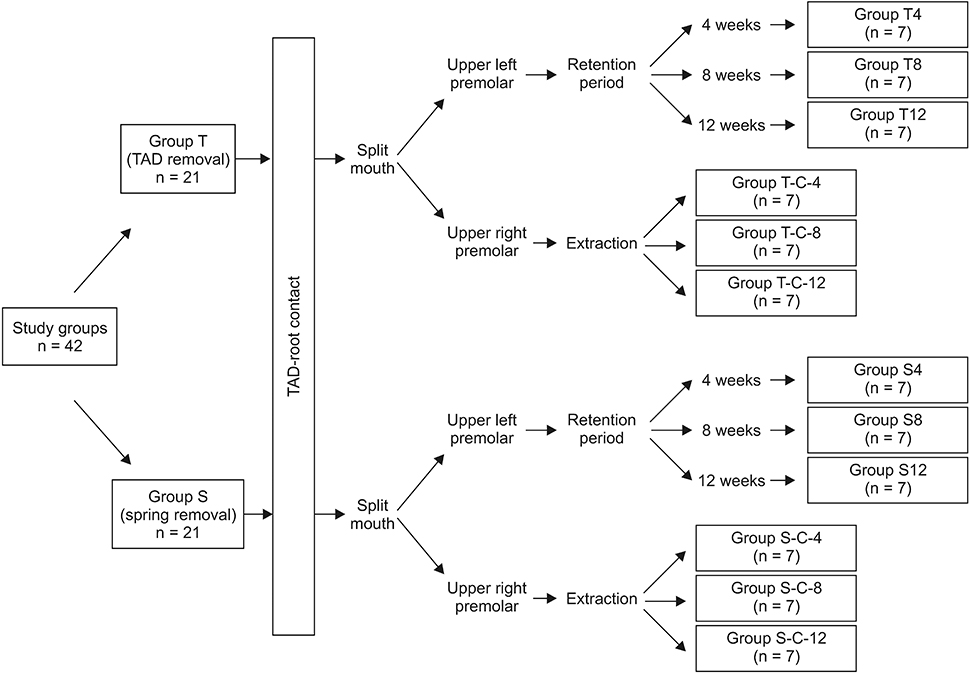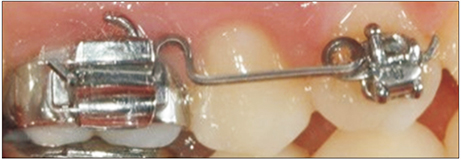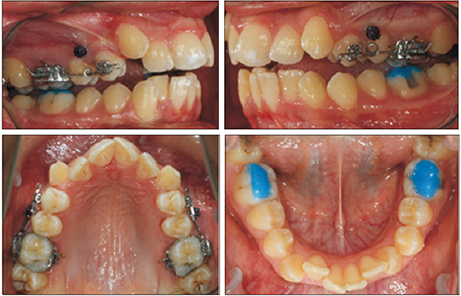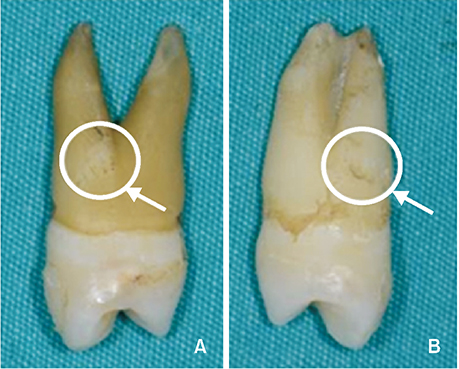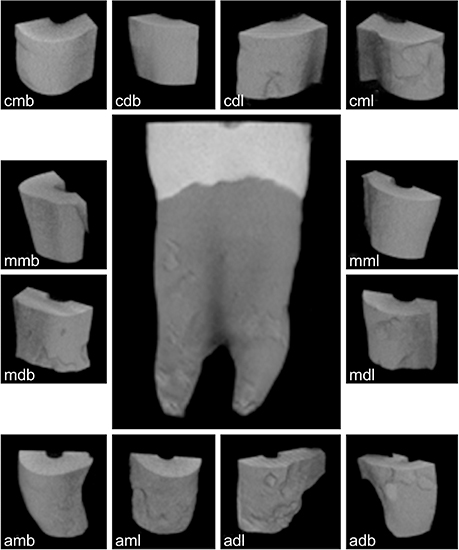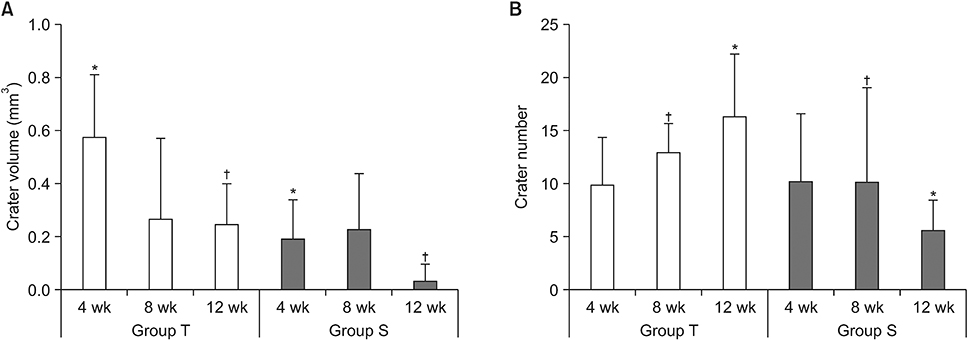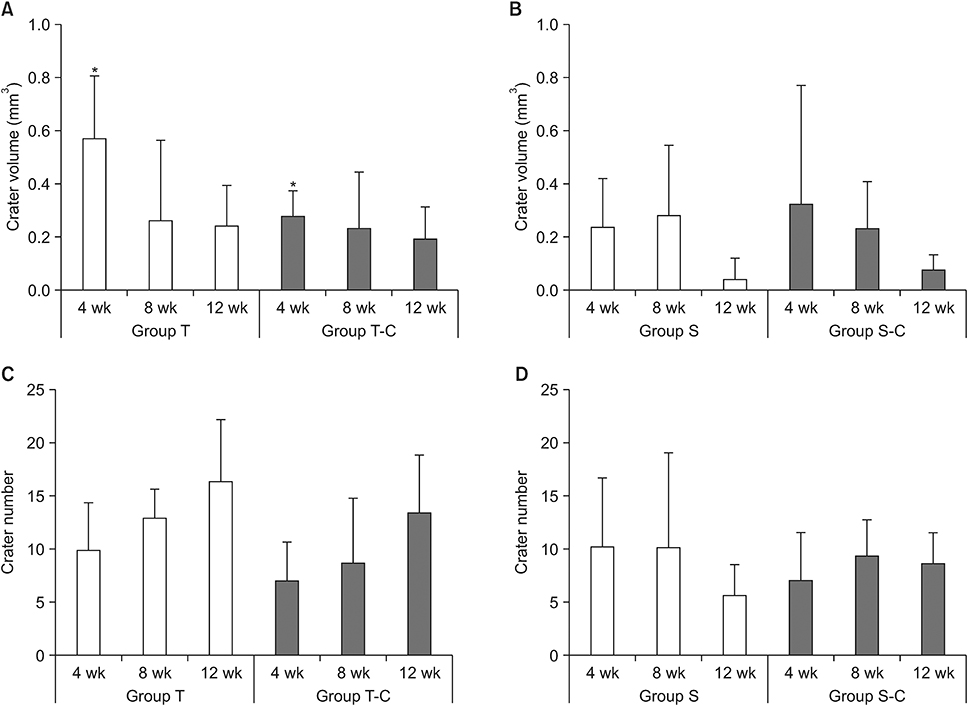Korean J Orthod.
2019 Mar;49(2):106-115. 10.4041/kjod.2019.49.2.106.
Effects of orthodontic force on root surface damage caused by contact with temporary anchorage devices and on the repair process
- Affiliations
-
- 1Department of Orthodontics, Faculty of Dentistry, Çanakkale Onsekiz Mart University, Çanakkale, Turkey. dt.celikozge@gmail.com
- 2Private Practice, Istanbul, Turkey.
- KMID: 2453974
- DOI: http://doi.org/10.4041/kjod.2019.49.2.106
Abstract
OBJECTIVE
This study aimed to evaluate the effects of force loading on root damage caused by contact with temporary anchorage devices (TADs) during orthodontic treatment and to examine the repair process 4, 8, and 12 weeks after TAD contact by micro-computed tomography (CT).
METHODS
We enrolled 42 volunteers who required bilateral upper first premolar extractions. The experimental study design was as follows. For both first premolars, cantilever springs were placed, and then TADs were immediately inserted between the premolars of all volunteers. According to the removal order of the appliances, the participants were divided into the TAD group (Group T: n = 21, only TAD removal) and the spring group (Group S: n = 21, only spring removal). A split-mouth design was adopted in both groups as follows. For each volunteer, the left premolars were extracted 4, 8, or 12 weeks after TAD-root contact. The right premolars were extracted immediately after contact in both groups (Groups T-C and S-C) and used as positive controls. Resorption volumes and numbers of craters were determined by micro-CT.
RESULTS
The numbers of resorption craters were higher in Group T than in Group S at 8 and 12 weeks (p < 0.01). Crater volumes were higher in Group T than in Group S at 4 and 12 weeks (p < 0.01, both).
CONCLUSIONS
Root injury was not completely repaired 12 weeks after root-TAD contact, even when the TADs were removed in cases of continuous force application.
MeSH Terms
Figure
Cited by 1 articles
-
Does mini-implant-supported rapid maxillary expansion cause less root resorption than traditional approaches? A micro-computed tomography study
Rukiye Alcin, Siddik Malkoç
Korean J Orthod. 2021;51(4):241-249. doi: 10.4041/kjod.2021.51.4.241.
Reference
-
1. Papadopoulos MA, Tarawneh F. The use of miniscrew implants for temporary skeletal anchorage in orthodontics: a comprehensive review. Oral Surg Oral Med Oral Pathol Oral Radiol Endod. 2007; 103:e6–e15.
Article2. Alves M Jr, Baratieri C, Mattos CT, Araújo MT, Maia LC. Root repair after contact with mini-implants: systematic review of the literature. Eur J Orthod. 2013; 35:491–499.
Article3. Cakir E, Malkoç S, Kirtay M. Treatment of Class II malocclusion with mandibular skeletal anchorage. Am J Orthod Dentofacial Orthop. 2017; 151:1169–1177.
Article4. Reynders RM, Ronchi L, Ladu L, Di Girolamo N, de Lange J, Roberts N, et al. Barriers and facilitators to the implementation of orthodontic mini implants in clinical practice: a systematic review. Syst Rev. 2016; 5:181.
Article5. Kim JK, Park YC, Vanarsdall RL. Applications of orthodontic mini implants. Chicago: Quintessence Publishing Company;2007.6. Kravitz ND, Kusnoto B. Risks and complications of orthodontic miniscrews. Am J Orthod Dentofacial Orthop. 2007; 131:4 Suppl. S43–S51.
Article7. Liou EJ, Pai BC, Lin JC. Do miniscrews remain stationary under orthodontic forces? Am J Orthod Dentofacial Orthop. 2004; 126:42–47.
Article8. Kadioglu O, Büyükyilmaz T, Zachrisson BU, Maino BG. Contact damage to root surfaces of premolars touching miniscrews during orthodontic treatment. Am J Orthod Dentofacial Orthop. 2008; 134:353–360.
Article9. Maino BG, Weiland F, Attanasi A, Zachrisson BU, Buyukyilmaz T. Root damage and repair after contact with miniscrews. J Clin Orthod. 2007; 41:762–766. quiz 750.10. Ahmed V KS, Rooban T, Krishnaswamy NR, Mani K, Kalladka G. Root damage and repair in patients with temporary skeletal anchorage devices. Am J Orthod Dentofacial Orthop. 2012; 141:547–555.
Article11. Demir N, Ozturk AN, Malkoc MA. Evaluation of the marginal fit of full ceramic crowns by the micro-computed tomography (micro-CT) technique. Eur J Dent. 2014; 8:437–444.
Article12. Malkoç MA, Sevimay M, Tatar İ, Çelik HH. Micro-CT detection and characterization of porosity in luting cements. J Prosthodont. 2015; 24:553–561.
Article13. Harris DA, Jones AS, Darendeliler MA. Physical properties of root cementum: part 8. Volumetric analysis of root resorption craters after application of controlled intrusive light and heavy orthodontic forces: a microcomputed tomography scan study. Am J Orthod Dentofacial Orthop. 2006; 130:639–647.
Article14. Chan EK, Darendeliler MA, Petocz P, Jones AS. A new method for volumetric measurement of orthodontically induced root resorption craters. Eur J Oral Sci. 2004; 112:134–139.
Article15. Weiland F. Constant versus dissipating forces in orthodontics: the effect on initial tooth movement and root resorption. Eur J Orthod. 2003; 25:335–342.
Article16. Malek S, Darendeliler MA, Swain MV. Physical properties of root cementum: part I. A new method for 3-dimensional evaluation. Am J Orthod Dentofacial Orthop. 2001; 120:198–208.
Article17. Cheng LL, Türk T, Elekdağ-Türk S, Jones AS, Petocz P, Darendeliler MA. Physical properties of root cementum: Part 13. Repair of root resorption 4 and 8 weeks after the application of continuous light and heavy forces for 4 weeks: a microcomputed-tomography study. Am J Orthod Dentofacial Orthop. 2009; 136:320. e1–320. e10. discussion 320-1.
Article18. Kim H, Kim TW. Histologic evaluation of root-surface healing after root contact or approximation during placement of mini-implants. Am J Orthod Dentofacial Orthop. 2011; 139:752–760.
Article19. Hembree M, Buschang PH, Carrillo R, Spears R, Rossouw PE. Effects of intentional damage of the roots and surrounding structures with miniscrew implants. Am J Orthod Dentofacial Orthop. 2009; 135:280.e1–280.e9. discussion 280-1.
Article20. Renjen R, Maganzini AL, Rohrer MD, Prasad HS, Kraut RA. Root and pulp response after intentional injury from miniscrew placement. Am J Orthod Dentofacial Orthop. 2009; 136:708–714.
Article21. Huang LH, Shotwell JL, Wang HL. Dental implants for orthodontic anchorage. Am J Orthod Dentofacial Orthop. 2005; 127:713–722.
Article22. Lee YK, Kim JW, Baek SH, Kim TW, Chang YI. Root and bone response to the proximity of a mini-implant under orthodontic loading. Angle Orthod. 2010; 80:452–458.
Article23. Gonzales C, Hotokezaka H, Darendeliler MA, Yoshida N. Repair of root resorption 2 to 16 weeks after the application of continuous forces on maxillary first molars in rats: a 2- and 3-dimensional quantitative evaluation. Am J Orthod Dentofacial Orthop. 2010; 137:477–485.
Article24. Rygh P. Orthodontic root resorption studied by electron microscopy. Angle Orthod. 1977; 47:1–16.25. Reitan K. Effects of force magnitude and direction of tooth movement on different alveolar bone types. Angle Orthod. 1964; 34:244–255.26. Owman-Moll P, Kurol J, Lundgren D. Repair of orthodontically induced root resorption in adolescents. Angle Orthod. 1995; 65:403–408.27. Xu X, Zhou J, Yang F, Wei S, Dai H. Using micro-computed tomography to evaluate the dynamics of orthodontically induced root resorption repair in a rat model. PLoS One. 2016; 11:e0150135.
Article
- Full Text Links
- Actions
-
Cited
- CITED
-
- Close
- Share
- Similar articles
-
- The effet of types of orthodontic force on the root resorption and repair in rat molar
- Orthodontic Traction of the Permanent Molar Using Skeletal Anchorage: A Case Report
- Frictional forces in the fixed orthodontic appliance during tooth movement
- The effect of early loading on the direct bone-to-implant surface contact of the orthodontic osseointegrated titanium implant
- Histologic assessment of the biological effects after speedy surgical orthodontics in a beagle animal model: a preliminary study

